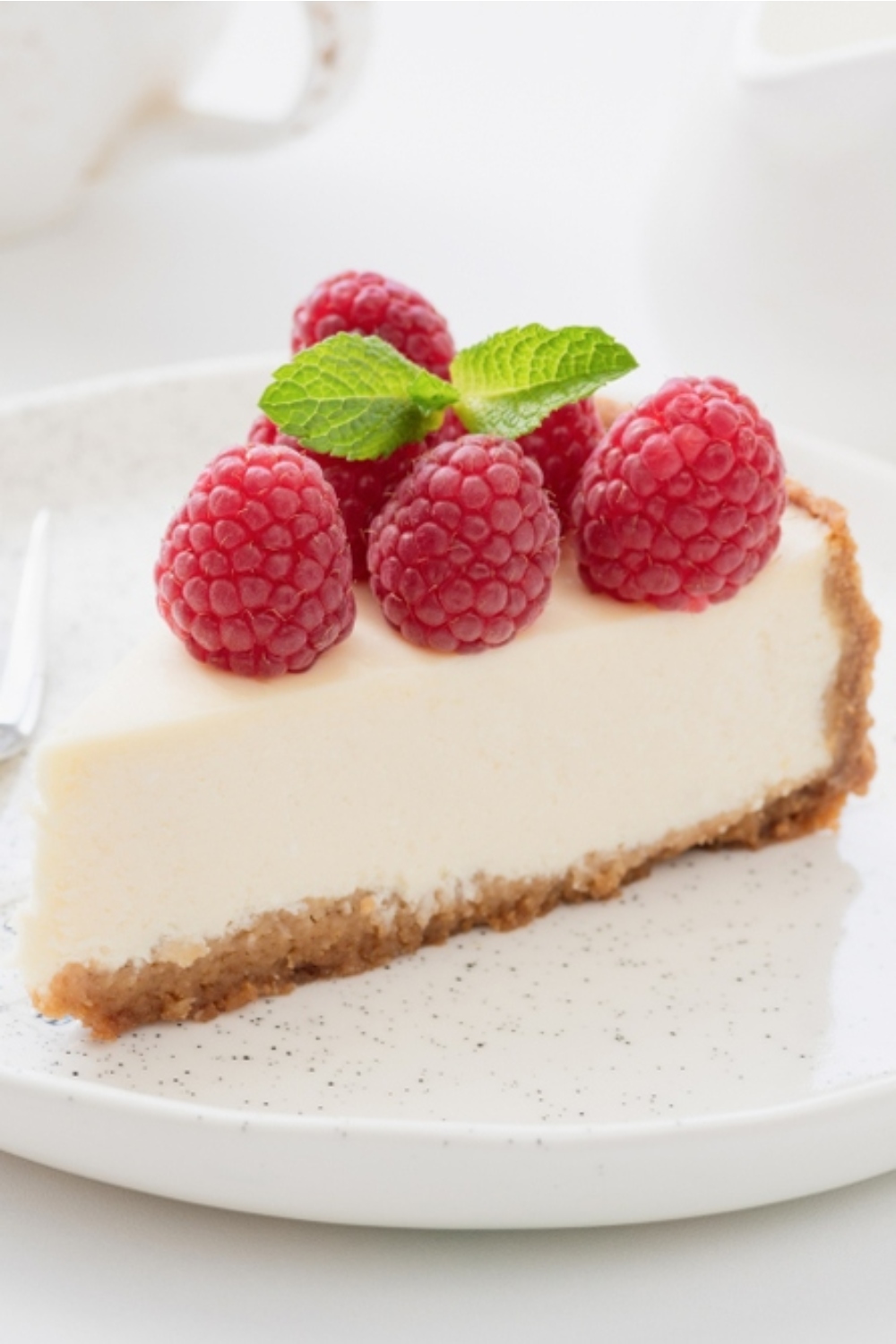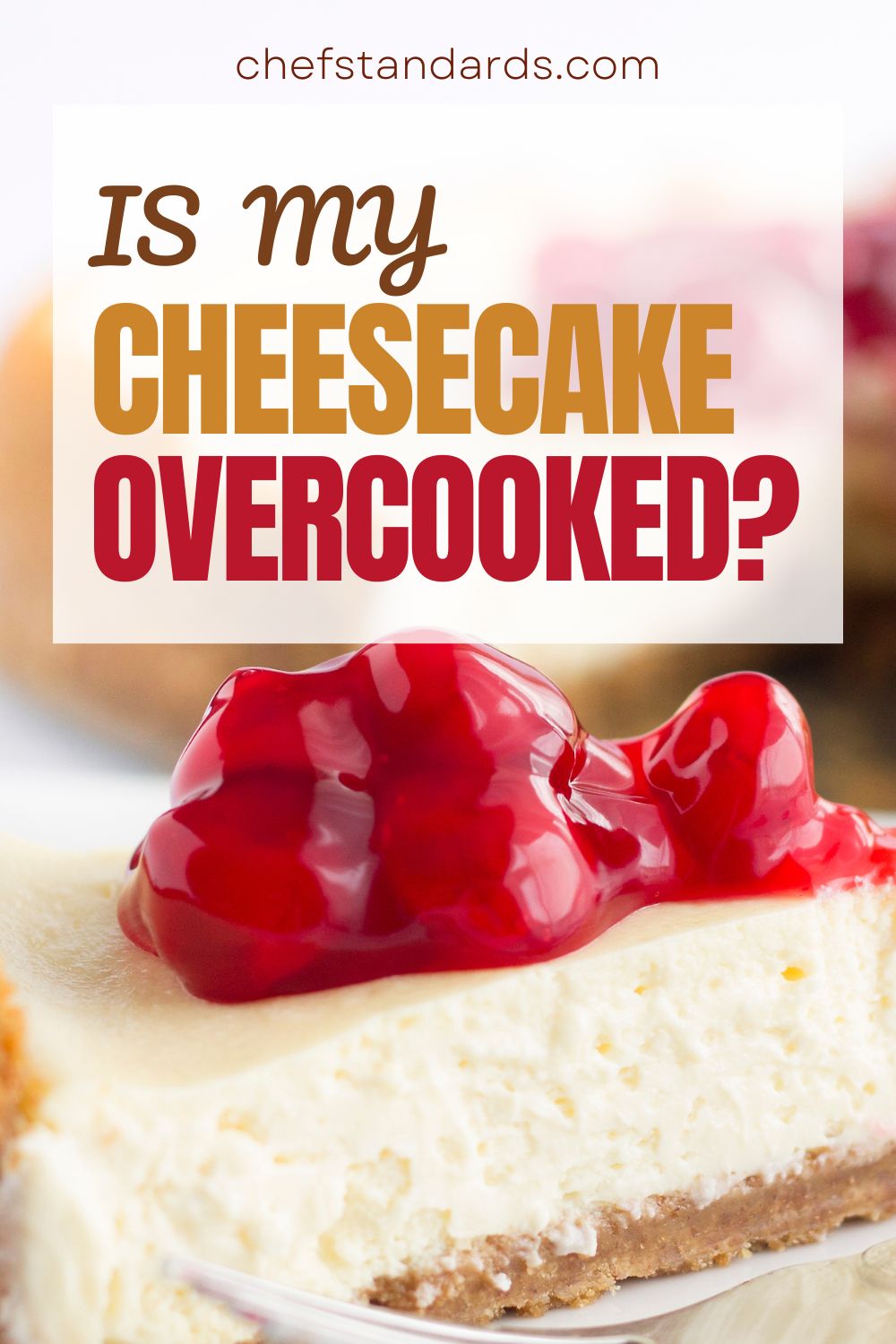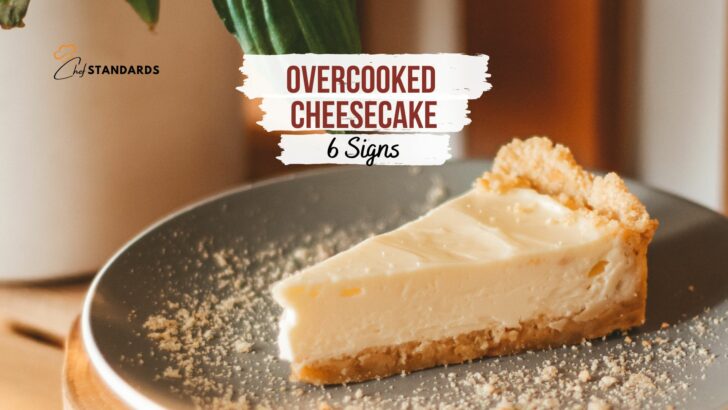Cheese is one of the most used ingredients in the world and cheesecake is certainly a very popular sweet. Considering this, you can always make this sweet classic and enjoy its wonderful flavors.
However, it is not everyone’s cup of tea, but if you make it the right way, there will always be something for everyone’s taste buds.
But you must know how to do that properly because undercooked or overcooked cheesecake is definitely not something that will make even the biggest cheesecake lover smile.
So, if you are making cheesecake for the first time, or if you are just still inexperienced, here are a few signs that your cheesecake is undercooked and what you can do about it.
What Are The Signs Of Overcooked Cheesecake?

You just pulled your cheesecake out of the oven and let it cool at room temperature to enjoy it with your friends and family. But you notice that there is something wrong. Maybe your cheesecake is overcooked? Here is how to know.
1. Cracked Surface
When cheesecake is overcooked, the cracks are not as pretty as when it’s baked the right way.
Butter is the main component that makes cheesecake so delicious. When you bake it too long or overheat it, the butter separates from the rest of the ingredients and creates cracks on top of your cake.
This is because the cake dries out, leading to a texture that is not enjoyable to eat.
Also, those cracks tend to be dark brown or black in color, as well as lumpy in appearance, and this is not something you want to see on your cake.
2. Shrinking From the Sides
Once baked goods are properly cooked, all of their ingredients are quite stable and won’t separate that easily.
However, an overcooked cheesecake may shrink away from the sides of the pan more than a properly cooked one.
This can result in a gap between the cheesecake and the pan. If you notice this, know that your cheesecake is overcooked and that you will have to make some additional adjustments.
3. Dryness
Dryness happens when the cheesecake is overcooked. Some people think that this is a natural process, but it can also be prevented by proper preparation when making the cake batter.
The key to preventing dryness is to ensure that the cake batter is not over-mixed or over-beaten. Use a spatula or whisk to mix and stir the batter in one direction only – from the bottom of the bowl upwards.
You can also try to prevent this from happening by wrapping your cheesecake in aluminum foil or plastic wrap so the heat and water don’t escape.
4. Hard and Dense Texture
It is normal for some types of baked goods to have a harder texture, and some people even don’t mind eating a cheesecake is like that.
Unfortunately, it is almost always a sign of overcooked cheesecake because it is supposed to be smooth and creamy.
Namely, overcooking can cause the proteins in the cheesecake to over-set, leading to a dense and rubbery texture rather than the smooth, creamy texture you’d expect.
5. Crumbly and Grainy Surface
When you pull your cheesecake out of the oven and let it stay at room temperature to cool down, it is not out of hand to touch it to determine if it is overcooked or not.
If it is overcooked, it may feel crumbly or grainy due to excessive drying during baking.
If this is the case, your cheesecake is definitely overcooked and will need some fixing.
6. No Jiggle in the Center
The reason why overcooked cheesecake don’t jiggle in the center is because of the protein in the dessert. Everyone knows it as the jiggle dessert.
When it’s cooked at high temperatures, the gelatin starts breaking down, and its structure becomes more firm. This causes some of the fat molecules in the cheesecake to move around, and no jiggle happens.
How Can You Fix Overcooked Cheesecake?

Fixing an overcooked cheesecake can certainly be a bit challenging, but there are some steps you can take to salvage it and improve its texture:
• Use a Water Bath: If the cheesecake is only slightly overcooked and has cracks on the surface, you can try using a water bath to soften it.
Place the overcooked cheesecake back in the springform pan and wrap the outside of the pan with a damp kitchen towel.
Bake the cheesecake in a preheated oven at a very low temperature (around 200°F or 95°C) for about 15-20 minutes. The moisture from the towel and gentle heat may help soften the cheesecake and reduce the cracks.
• Add Moisture: Create a simple syrup by heating equal parts of sugar and water until the sugar dissolves. Let the syrup cool slightly and then brush it over the surface of the overcooked cheesecake.
The syrup will add some moisture to the cheesecake and may help to improve its texture.
• Make a Cheesecake Sauce: Prepare a smooth and creamy cheesecake sauce using ingredients like softened cream cheese, a bit of sugar, and heavy cream. Spread the sauce over the top of the overcooked cheesecake to add moisture and flavor.
• Serve With Toppings: Sometimes, this problem can be solved very easily.
Adding flavorful toppings like fruit compote, caramel sauce, chocolate ganache, or even flavorful honeycomb can help balance out the dryness of an overcooked cheesecake and enhance its overall taste and texture.
Is There Anything You Can Do With It?
If you don’t want to fix it this way or if you are just not satisfied with the result, there are ways to transform it into something even more delicious.
• Cheesecake Crumbs: If the overcooked cheesecake is still edible but not visually appealing, you can crumble it into fine crumbs.
These crumbs can be used as a delicious crust for other desserts like cheesecake bars, and parfaits, or as a topping for ice cream.
• Cheesecake Truffles: Mix the overcooked cheesecake with a little melted chocolate and roll it into small balls to make cute cheesecake truffles.
You can then coat them in cocoa powder, crushed nuts, sprinkles, or even cacao powder (one of the best cocoa powder substitutes) for a delightful treat.
• Cheesecake Parfait: Layer the overcooked cheesecake with whipped cream, fresh fruit, and cookie crumbs to create a delectable cheesecake parfait.
• Cheesecake Ice Cream: Blend the overcooked cheesecake with some milk or cream and freeze the mixture to make a creamy, decadent cheesecake-flavored ice cream.
• Cheesecake Smoothie: Blend the overcooked cheesecake with milk, yogurt, and your favorite fruits to create a rich and creamy cheesecake smoothie.
You can refrigerate it for later, but I wouldn’t recommend freezing cheesecake smoothie.
• Cheesecake Dip: Mash the overcooked cheesecake and mix it with softened cream cheese and sweetener to make a flavorful cheesecake dip.
• Cheesecake Milkshake: Blend the overcooked cheesecake with ice cream, milk, or any other flavorings you like to make a luscious cheesecake milkshake.
• Cheesecake Popsicles: Mix the overcooked cheesecake with some milk or yogurt and freeze it in popsicle molds for a refreshing and indulgent dessert.
How To Properly Bake Cheesecake?

If you want to avoid these problems with overcooked cheesecake, it is essential to know how to properly bake it. I will give you the guidelines here, so you just have to read it carefully, and there won’t be any problems with your delicious cake.
1. Use the Right Ingredients: Use full-fat cream cheese, fresh eggs, and pure vanilla extract for the best results.
You can use many types of cheese. I like to use ricotta cheese, or some ricotta cheese substitutes, including cream cheese, cottage cheese, Greek yogurt, etc.
2. Preheat the Oven: Preheat your oven to the specified temperature in the recipe before placing the cheesecake inside. This ensures even baking from the start.
3. Prepare the Pan: Use a springform pan with a tight seal to prevent leakage. Grease the pan and line the bottom with parchment paper to make the removal easier.
4. Prepare the Crust: If your cheesecake recipe calls for a crust, press the crust mixture firmly into the bottom of the pan. Pre-bake the crust for a few minutes to prevent sogginess.
5. Use the Water Bath Method: To prevent cracking and ensure gentle, even baking, use a water bath.
Wrap the pan in aluminum foil, and then place it in a larger roasting pan filled with hot water that comes about halfway up the sides of the springform pan.
6. Bake at the Right Temperature: Follow the recipe instructions for the correct baking temperature. Cheesecakes are typically baked at low to moderate temperatures (around 300-325°F or 150-160°C) to prevent overcooked edges.
7. Watch the Baking Time: Keep a close eye on the cheesecake during the last 10-15 minutes of baking. The center should be slightly jiggly but not soupy when the pan is gently shaken.
8. Cool Gradually: Once the cheesecake is done baking, turn off the oven and crack the oven door open slightly.
Allow the cheesecake to cool gradually in the oven for about an hour before removing it to a wire rack to cool completely at room temperature. Cooling too quickly can cause the cheesecake to crack.
9. Refrigerate Cheesecake Before Serving: Cover the cheesecake with plastic wrap and refrigerate for at least 4 hours for a great flavor and texture. Additionally, according to the USDA’s Food Keeper App, you should consume cheesecake within 5 to 7 days of refrigeration.
Signs That Your Cheesecake Is Done
Knowing when your cheesecake is done is crucial to achieving the perfect texture, so here are the signs:
• Firm Edges, Slightly Jiggly Center: When you gently shake the pan, the outer edges of the cheesecake should be firm and set, while the center (about a 2 to 3-inch diameter circle) should have a slight jiggle or wobble.
The center will continue to set as the cheesecake cools.
• Moist, Not Wet: The surface of the cheesecake should appear moist but not wet. If you see pools of liquid on top, it may indicate that the cheesecake is undercooked.
• Lightly Browned Top: The top of the cheesecake should have a light golden-brown color. Be cautious not to over-brown the top, as it can result in overcooked edges.
• Pulling Away from Sides: As the cheesecake cools, it will start to slightly pull away from the sides of the pan. This is a good indicator that it’s done.
• Inserted Toothpick Comes Out Clean: If you’re uncertain about the center’s doneness, you can insert a toothpick into the center of the cheesecake. It should come out mostly clean. If the toothpick comes out with a liquid or raw batter, the cheesecake needs to bake more.
• Temperature Reading: The temperature should be around 150°F (65°C) in the center when you check it with an instant-read thermometer.


